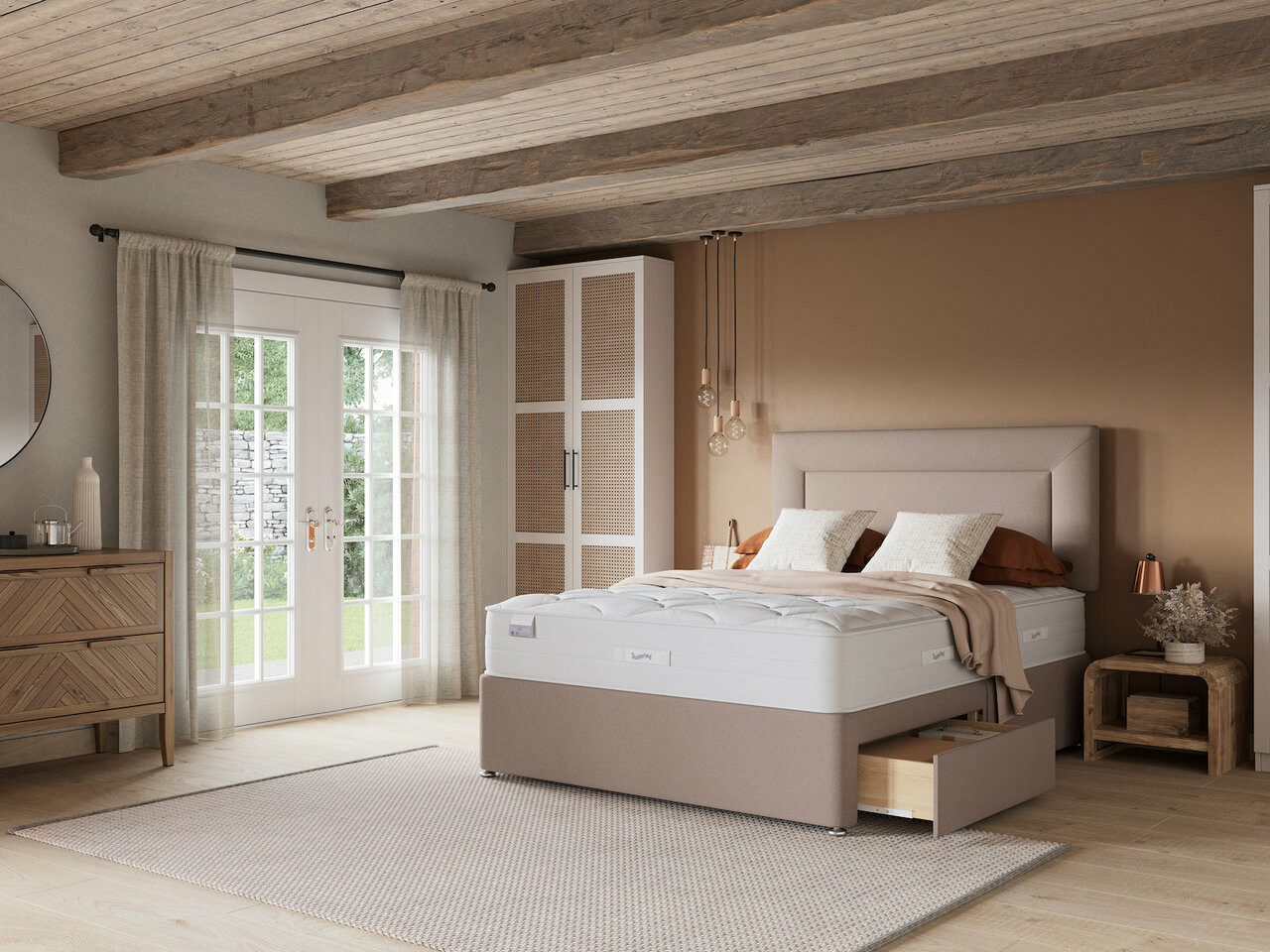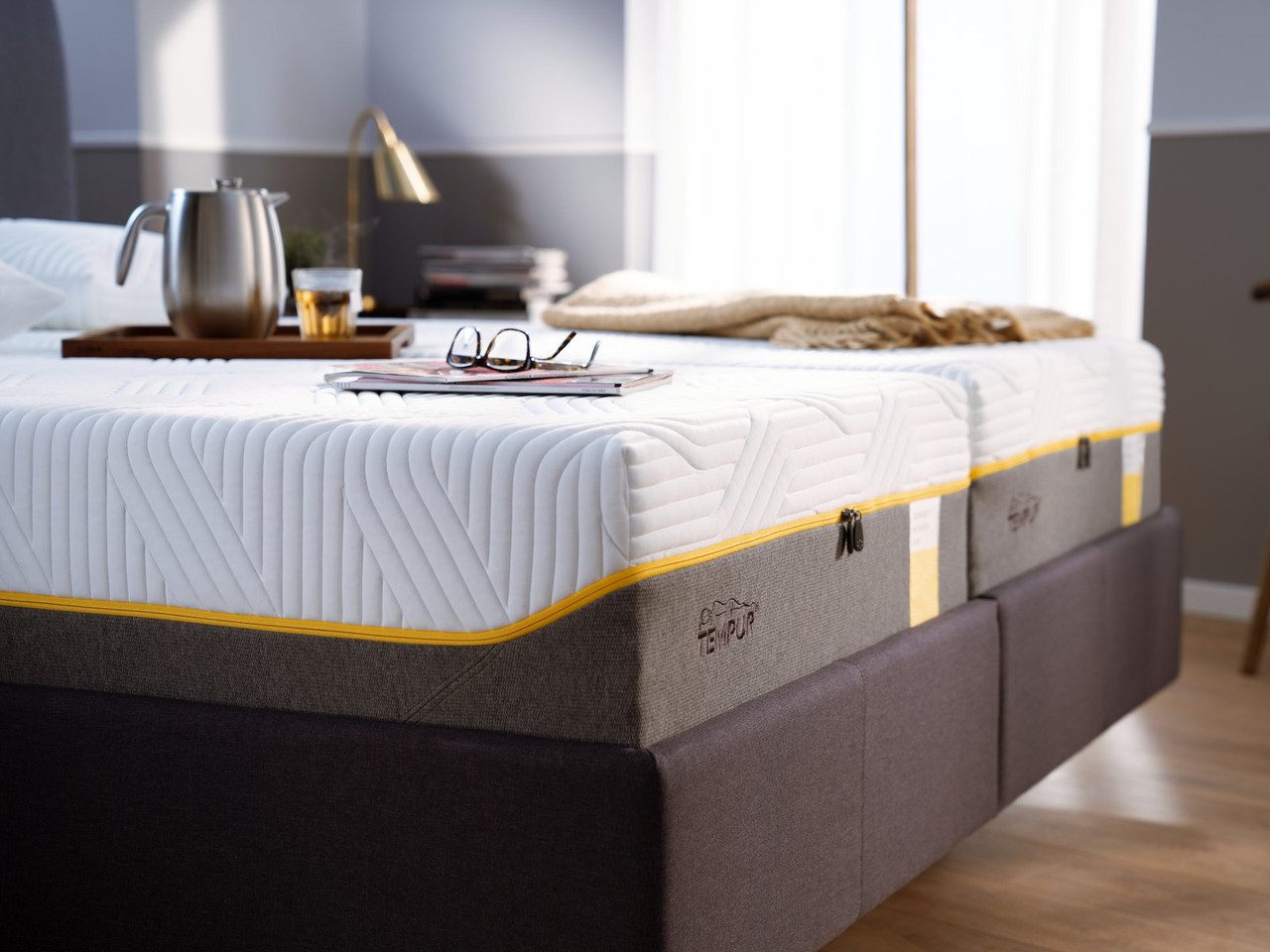Posted by Pam Johnson Head of Buying on 9th Aug 2022
Memory Foam Mattress Buying Guide
By now you’ve almost certainly heard plenty about memory foam mattresses. The internet is positively awash with adverts for these relatively modern inventions, while fans of memory foam just can’t wait to tell you about how great they’re sleeping.
If you’ve yet to be convinced by the practical benefits of foam, we’re here to fill you in. Our in depth guide to all things memory foam will give you everything you need to know about memory foam mattresses and mattress toppers, from their benefits (and negatives), to the best memory foam mattress brands and ranges.
The Best Memory Foam Mattress: A Quick Explainer
If you’ve lived your entire life with a sprung mattress, it’s time to enlighten you about memory foam mattresses and how they could potentially make you reassess what you thought you knew about sleep comfort.
What is memory foam?
Made using a common plastic polymer known as polyurethane, also referred to as PU, memory foam contains large macromolecules, each made up of monomers, smaller individual chemical units. Used in a whole range of products, from spray paint to car parts and skateboard wheels, PU is an incredibly versatile material. When it comes to your bed’s mattress, the type of PU used is what’s known as ‘viscoelastic’, which means it offers excellent elasticity. What does that mean? Simply put, memory foam can stretch and re-form before slowly returning to its original state. It’s this elasticity that makes memory foam so comfortable for so many sleepers.
Different memory foam mattress manufacturers will make their memory foam in slightly different ways, but the ultimate result tends to be the same; a soft, supportive material that conforms to your body, no matter how much you move.
Why is memory foam so comfortable?
Originally designed by NASA for use in space shuttles, memory foam slowly moulds to the body in response to the pressure of your weight. It’s this that makes a memory foam mattress so supportive for so many body types. Because it reacts differently depending on the amount of pressure it receives, the foam offers precision support where you most need it. Memory foam responds to heat, becoming more pliable as it warms with your body temperature, meaning it gets increasingly soft as you settle in. The foam also returns to its original shape slowly – a process known as hysteresis –helping to minimise the pressure on your spine and joints no matter the position you’re in.
Is memory foam right for everyone?
Over the years memory foam mattress technology has come on in leaps and bounds. This means that those early memory foam mattresses that perhaps didn’t suit all sleepers are a thing of the past. Manufacturers have made significant advances in mattress design and now memory foam is used in a wide variety of ways that aimsfor the ultimate in nighttime comfort. That said, even the top rated memory foam mattress won’t suit every single person. This is simply because mattresses are an extremely personal thing with no one size fits all solution.However, whether it’s an all-encompassing memory foam mattress, a simple memory foam mattress topper or a hybrid bed blending springs and foam to best effect thereshouldalmost certainlybe a memory foam solution to suit your needs.
Slumberland Air 3.0 Memory 3000 Mattress
Shop our Slumberland Air Memory Mattresses & Beds
The Pros and Cons: Even The Best Foam Mattress Has Both
Wondering if a memory foam mattress might suit you? Here are just a few memory foam mattress pros and cons. Do, however, bear in mind that everyone has a different experience and so the best course of action is to pop into a Bensons for Beds showroom to try out a variety of mattresses.
The best memory foam mattress positives
- Memory foam offers great joint support: the foams supportive, contouring properties make for excellent pressure point relief, taking the weight off of your knees, hips and shoulders that should reduce discomfort overnight and the next morning.
- Memory foam can offer allergy relief: naturally hypoallergenic memory foam can prove to be ideal for people with allergies, asthma and skin complaints. With less internal workings than a traditional spring mattress, memory foam is less likely to collect dust, dust mites, pollen and pet dander. It’s also free of common allergy triggers like wool, feathers and down.
- Memory foam promotes good spinal alignment: bad back making bedtime a nightmare? The best firm memory foam mattress will ensure that your spine is kept in its correct neutral position while you sleep, helping to negate spinal issues.
- Memory foam offers excellent motion isolation: if your partner’s nocturnal movements disrupt your shut eye, a memory foam mattress could be the answer to your prayers. Unlike a sprung mattress, which can be prone to motion transfer (the bounce you feel when your sleeping partner moves around), a memory foam bed absorbs movement effectively, meaning that when they move around, you remain perfectly, blissfully unaware.
- Memory foam is highly durable: need a bed that’s built to last? Mattresses are an expensive investment so we want them to last for as long as possible, which is just one reason why robust memory foam is so popular. With no internal springs or other high-tech, breakable gadgetry to go wrong, memory foam lasts well with no need for challenging upkeep. A high density (or firm) memory foam could maintain its shape for the longest of all, with even relatively cheap memory foam mattress designs can last upwards of seven years.
- Memory foam is suitable for adjustable beds: not just for the elderly, adjustable beds are a popular choice among those who have skeletal and muscular complaints, people with mobility issues, and even those who spend a lot of time reading, watching TV or even working in their bed. Flexible and robust, memory foam mattresses make for a great pairing with adjustable beds, allowing for a full range of movement without the risk of damage (though do be sure to the mattress manufacturer’s guidelines for electric bed compatibility).
The worst memory foam mattress negatives
- Memory foam can be heavy: made of a dense foam, your new memory mattress can prove to be pretty weighty. While this isn’t a problem for most, it can make getting a new bed into your room hard (although we at Bensons for Beds will deliver straight to your bedroom!). This can also make it a challenge to flip or turn your mattress or to lift it in order to tuck a flat sheet in with each bedding change. If you’d like to experience the benefits of memory foam without the weight consider a memory foam mattress topper or a hybrid bed instead.
- Memory foam isn’t resistant to water: though it resists allergens like dust and pollen, memory foam does have a tendency to suck up moisture lickety split, meaning it’s not always ideal if you sweat at night, tend to spill drinks often, or if the child you’re buying a new bed for is a bedwetter. This issue, however, is easily overcome with the addition of a high quality waterproof mattress protector or an insurance policy like our very own BedGuard, which covers you in case accidents happen.
- Memory foam can smell odd: ever heard of volatile organic compounds, or VOCs? They’re the source of that smell your new memory foam mattress might give off in a process known as off gassing. It’s a smell that not everyone likes and one of the reasons memory foam mattress manufacturers suggest leaving your mattress to air for a short while before first use. For most people VOCs aren’t a problem, in fact that new car smell we all love is the product of VOCs, but it seems that in a handful of people it could cause respiratory reactions. Plus, that VOC smell will eventually disappear anyway!
Tempur Sensation Elite Memory Foam Mattress
Memory foam v latex: what’s the difference?
Far be it from us to throw a cat amongst the pigeons but, well, that’s exactly what we’re going to do.
If you’re thinking about investing in a memory foam mattress you may also have come across its distant cousin, latex. While they’re similar in some ways, memory foam and latex are actually very different beasts. Not least in the way each one feels when you climb on board and start getting comfy.
While a memory foam will envelop you, a latex mattress provides less contouring and more of an overall sink beneath your body weight. This can be preferable for those who don’t like the feeling of being hugged into their bed. The extra bounce of a latex mattress means that you won’t get that sinking feeling that memory foam provides and it also means that your bed can respond more quickly to your movements, taking less time to mould to a new position as you move.
All that said, memory foam covers a far wider variety of mattress types than latex, giving you a plethora of great options to suit your needs and preferences.
Is a memory foam mattress topper good enough?
Fancy taking memory foam for a spin but not ready to invest in a whole new mattress? A memory foam topper could be the answer. Designed to sit on top of your existing mattress, a mattress topper may help to make an older mattress more comfortable, bringing it up to date with your current needs or a sleeping style that’s changed over the years.
A memory foam mattress topper could be a good choice for you if you’ve started to develop back or joint issues and feel that you require a little more support. It might also provide some extra comfort during pregnancy , when the additional weight of your burgeoning bump is putting pressure on every last joint and you’re forced into a new and unfamiliar sleeping position. It can also extend the life of a child’s mattress as they grow and change , requiring just a couple more years of improved support before investing in a new, more grown up bed.
Additionally, a mattress topper may make sleeping on an older mattress more palatable if you’re moving into a furnished rental property or student accommodation and really can’t afford to invest in a whole new mattress.
Unfortunately however, when it’s time for a new mattress, there’s no room for compromise. A mattress topper might seem like the ideal money-saving solution, but it won’t save an old, unhygienic or broken mattress. Take a look at our five tell tale signs that you need a new mattress before you try to eke another few years out of old faithful.
Is memory foam eco-friendly?
From choosing plant-based foods to waving goodbye to fast fashion and hopping on a bike instead of driving to the shops, making environmentally sound choices is becoming increasingly important to a great many of us. We’ve no doubt that goes for furnishing your bedroom too.
Mattresses have, understandably, come under a lot of scrutiny for their impact on the environment, not only when it comes to disposing of our old, out of date beds , but for the materials used in the construction and fire-proofing of mattresses too. And while memory foam may not top the list of the things that make Greta Thunberg most happy, they’re a vast improvement on older sprung mattresses, which can contain toxic chemicals and most of which are only good for (ugh!) landfill.
First the not so good – memory foam is chiefly petroleum based [iii], which isn’t any eco-warrior’s favourite headline news. Bulky and made of polyurethane, generally classed as an ‘other’ plastic, can memory foam mattresses can also be challenging to recycle. But here’s the good news – as we speak, experts are developing new ways to make good use of old memory foam, using chemical and mechanical processes to reclaim it for new purposes after its done its service as a faithful sleeping companion.
Lasting longer than your average sprung mattress – an average of ten to 15 years – memory foam mattresses can also be considered to be a more environmentally friendly option due to their impressive longevity.
Targeting net zero as part of the British Retail Consortium’s Climate Action Roadmap , Bensons for Beds is committed to reducing emissions and improving disposal of beds, with over 92,000 mattresses already recycled as part of the scheme. So whichever mattress you choose, when buying from Bensons for Beds you can rest assured you’re buying from a business committed to sustainability.
Memory Foam Mattress FAQs
If you’ve never had a memory foam mattress before you probably have a lot of questions. Let us try and answer them…
Are memory foam mattresses hot?
In short, yeas and no! Not so long ago memory foam mattresses got a bit of a reputation for heat retention and causing a ‘stuck’ feeling, however this is all a thing of the past thanks to modern memory foam technology. Manufacturers like iGel use clever propriety tech in their mattresses to give you the comfort and pressure relief of foam with none of the heat retention. In fact, iGel Advance temperature regulating material transfers heat 7x faster than everyday foam and offers moisture wicking properties intended to ensure a comfortable night’s sleep all year ‘round, even if you tend to get hot at night. Other mattresses, meanwhile, may offer cool-feel covers or air holes designed to promote the flow of air, helping to minimise any extremes of temperature.
Are memory foam mattresses expensive?
When memory foam mattresses initially hit the market they were prohibitively expensive for many buyers. However with more and more manufacturers hopping on the memory foam bandwagon and memory foam ‘recipes’ honed to perfection over the years you’re now truly spoiled for choice, whether you have thousands to spend on a really, really good memory foam mattress or you’re on a strict budget. The best affordable memory foam mattress will be made using a durable, high quality foam with temperature regulating qualities. We like the eve mattress range for quality memory foam at an affordable price.
How should I take care of my memory foam mattress?
Taking care of memory foam mattresses should be as easy as giving them a regular turn and/or rotation according to the mattress manufacturer’s instructions to reduce the risk of losing support in areas subject to pressure. When changing sheets you may also wish to carefully run a vacuum cleaner over your mattress or even sprinkle it with a little baking soda (leave to stand for two hours or so before vacuuming the powder away). This helps to minimise allergens and reduce odours. As with any mattress, prevention is better than cure. Use a mattress protector and avoid getting memory foam wet to help it last as long as possible.
Will a memory foam mattress topper do?
If you’re on a budget or not quite ready to switch out your mattress, a memory foam mattress topper can give you many of the benefits of foam at a reduced cost. Do remember though that even the best memory foam mattress topper is no replacement for a really good mattress, especially if your current bed is on its last legs. We’re talking broken and creaking springs or a bed that’s been with you for longer than its recommended lifespan (usually ten years). And while a memory foam mattress topper might breathe new life into a mattress you’re not getting on well with do bear in mind that it’ll need replacing more quickly than a whole new mattress, usually within five years.
Are memory foam mattresses suitable for front sleepers?
However you choose to sleep at night, there will probably be a memory foam mattress to suit your needs, even you front sleepers who need ultra-firm support to keep their pelvises from sinking into the bed and causing lower back discomfort. For side sleepers, memory foam offers excellent pressure relief, protecting hips, knees and shoulders from pain, while back sleepers get good lumbar support. For these reasons, memory foam mattresses are especially suitable for people who might sleep in a variety of different positions over the course of an evening.
Choosing the best memory foam mattress for you at Bensons for Beds
Whether you’re seeking to buy from the top rated memory foam mattress brands, like Tempur or eve, or you’re looking for the best cooling memory foam mattress in your budget, we’ve got them all at Bensons for Beds. And thanks to our highly knowledgeable team and our smart sleeppro® system, you’ll barely need to lift a finger when it comes to memory foam mattress research. All you have to do is kick back and relax on our instore mattress samples and take your time making the decision that’s right for you. But what if that mattress that felt like a dream in the showroom just doesn’t cut it at home? Easy! Simply take advantage of our forty night comfort guarantee.
To place an order today or speak to one of our expert advisors give us a call on 0808 144 6160 or pay a visit to your nearest Bensons for Beds showroom.
REFERENCES
[ii] polymer | Description, Examples, Types, Material, Uses, & Facts | Britannica
[iii] The Origins of Plastics - Live Green and Earn Points - Recyclebank
SOURCES
Memory Foam vs. Spring Mattresses: Pros and Cons of Each (healthline.com)
Best Mattress for Stomach Sleepers 2022 | Sleep Foundation
Best Mattress for Back Sleepers of 2022 | Sleep Foundation
Best Mattress for Side Sleepers 2022 | Sleep Foundation
How Often Should You Change Your Mattress? Plus Why It Matters (healthline.com)
Because You Asked: How Eco-friendly Are Foam Mattresses? - Live Green - Recyclebank






